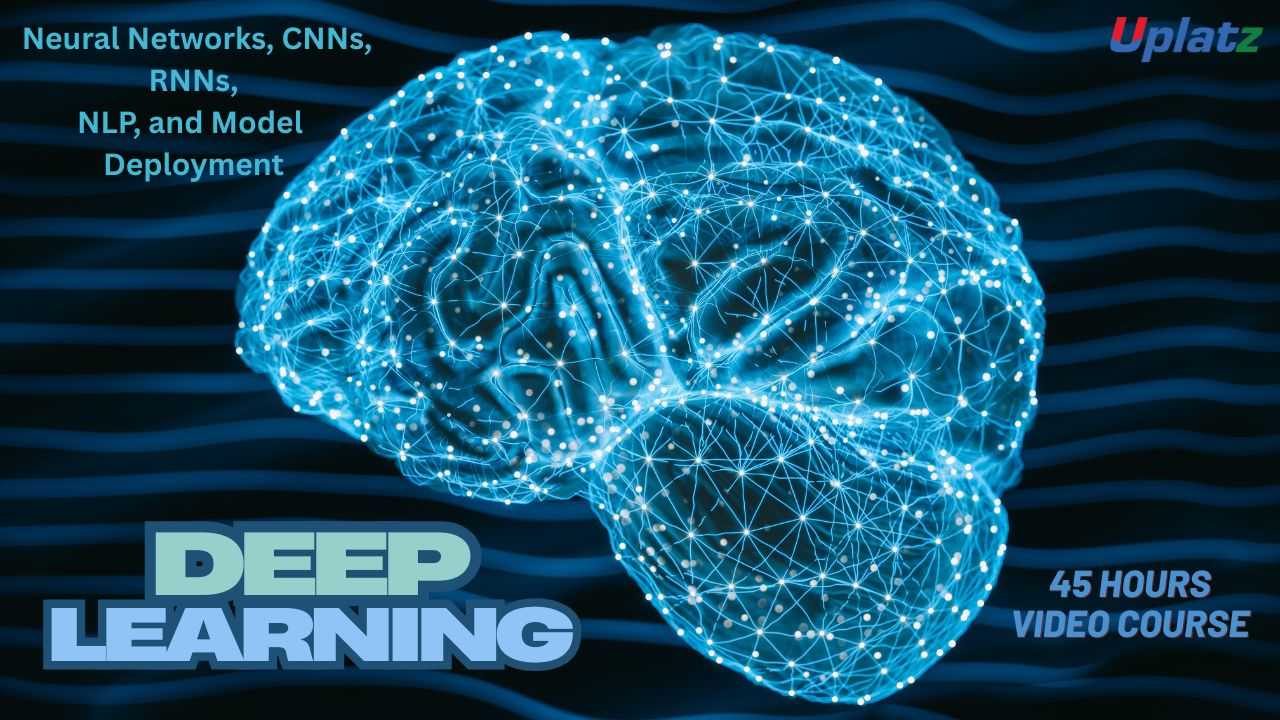Deep Learning: Neural Networks, CNNs, RNNs, NLP, and Deployment
Master neural networks, CNNs, RNNs, NLP, model deployment to become Deep Learning expert in real-world AI applications. Learn Deep Learning like a pro Price Match Guarantee
Full Lifetime Access
Access on any Device
Technical Support
Secure Checkout
Course Completion Certificate
Price Match Guarantee
Full Lifetime Access
Access on any Device
Technical Support
Secure Checkout
Course Completion Certificate
 92% Started a new career
BUY THIS COURSE (
92% Started a new career
BUY THIS COURSE (GBP 12 GBP 29 )-
 96% Got a pay increase and promotion
96% Got a pay increase and promotion
Students also bought -
-

- Data Science with Python
- 45 Hours
- GBP 12
- 2931 Learners
-

- Premium Career Track - Chief Data and Analytics Officer (CDAO)
- 700 Hours
- GBP 39
- 1642 Learners
-

- Data Visualization in R
- 10 Hours
- GBP 12
- 72 Learners

Deep Learning: Neural Networks, CNNs, RNNs, NLP, and Deployment – Self-Paced Online Course
Deep Learning: Neural Networks, CNNs, RNNs, NLP, and Deployment is a comprehensive and immersive training program designed for individuals seeking to master the core technologies behind modern Artificial Intelligence. With a practical, hands-on approach and an emphasis on real-world applications, this course equips you with the knowledge and skills required to design, build, train, and deploy advanced deep learning models using cutting-edge tools and frameworks.
Deep learning has emerged as one of the most transformative fields in technology today, powering everything from recommendation systems and voice assistants to autonomous vehicles and medical imaging diagnostics. This course aims to demystify the complexities of deep learning and make it accessible to learners with a basic understanding of programming and machine learning.
Throughout the course, you will explore the architecture and functionality of Artificial Neural Networks (ANNs), Convolutional Neural Networks (CNNs), Recurrent Neural Networks (RNNs), and key techniques in Natural Language Processing (NLP). You will not only understand how these models work theoretically but also gain hands-on experience by implementing them from scratch and with the help of popular frameworks such as TensorFlow and PyTorch.
Each module in the course is meticulously crafted to build both conceptual clarity and technical proficiency. You’ll begin with foundational neural network structures, learn how to handle data preprocessing, and then progress through specialized models like CNNs for image classification, RNNs for time series or sequence modeling, and transformer-based architectures for NLP tasks. Finally, you will discover how to deploy trained models into real-world environments, making your skills truly industry-ready.
This course is not just about learning algorithms—it’s about solving problems and delivering value through intelligent automation and AI-driven decision-making. Whether you're developing a chatbot, building a recommendation engine, performing sentiment analysis, or deploying a real-time object detection system, this course will guide you from the basics to the final deployment pipeline.
Who Should Take This Course
This course is ideally suited for:
- Aspiring AI Engineers looking to launch a career in artificial intelligence and deep learning.
- Data Scientists and Analysts wanting to enhance their understanding of neural networks and NLP.
- Machine Learning Practitioners aiming to expand their skill set to include deep learning frameworks and model deployment.
- Software Developers and Engineers interested in building intelligent applications using AI.
- Researchers and Academics seeking hands-on training to complement theoretical knowledge in deep learning and NLP.
No prior experience in deep learning is required, though familiarity with Python and basic machine learning concepts will be helpful.
What Makes This Course Unique
What sets this course apart is its end-to-end focus—from building models to deploying them in practical environments. Many online courses emphasize only the theory or coding part; this course ensures you're capable of taking a model from the idea stage to real-world implementation. With numerous mini-projects and case studies integrated throughout, you’ll not only learn how deep learning works but also how to apply it effectively across different domains such as computer vision, time series forecasting, and text analytics.
You’ll also gain exposure to a variety of tools and libraries, learning best practices in model optimization, hyperparameter tuning, overfitting control, and using GPUs for faster computation. Additionally, the course introduces you to MLOps principles and techniques for model deployment, such as serving models through REST APIs and deploying on cloud platforms.
How to Use This Course Effectively
To maximize your learning and outcomes from this course, consider the following strategies:
- Start with Clear Objectives: Before you dive in, identify your goals. Are you aiming to transition into a deep learning role? Build a portfolio project? Learn to deploy NLP models? Knowing your purpose will help you stay focused and motivated throughout the course.
- Follow the Recommended Path: While the course is self-paced, the content is structured in a logical sequence to build upon previous knowledge. Proceed through the modules in order to develop a solid foundation before moving on to advanced topics like RNNs or deployment strategies.
- Engage with Hands-On Coding Exercises: Theory is essential, but true understanding comes from application. Every module includes practical exercises and labs. Complete these diligently and don’t hesitate to tweak the code or experiment with different parameters to gain deeper insights.
- Build Alongside the Instructor: As you follow the video tutorials, code along in your own Jupyter Notebook or IDE. This not only reinforces your understanding but also helps you develop coding fluency with TensorFlow, PyTorch, and related libraries.
- Work on Projects Independently: In addition to the guided examples, try building your own mini-projects. Choose a problem domain you're interested in—like image recognition, time series prediction, or sentiment analysis—and apply the techniques you’ve learned.
- Maintain a Learning Journal: Document your learning journey, track the concepts you’ve mastered, note areas where you face challenges, and summarize key takeaways from each module. This habit will make revision easier and help you prepare for technical interviews or certifications.
- Use Discussion Forums and Peer Networks: If the course is hosted on a platform with community support, use it actively. Ask questions, share your solutions, and learn from others. Collaborating with peers can offer fresh perspectives and faster problem-solving.
- Review and Revisit Complex Topics: Deep learning involves intricate mathematical and architectural concepts. Don’t rush. Rewatch videos, revisit readings, and retry exercises as needed. Use external resources like documentation or research papers to enrich your understanding.
- Prepare for Deployment: The final modules guide you through deployment techniques—don’t skip them. Being able to serve your models in production is a valuable skill that sets you apart. Use the deployment exercises to build a functional demo or end-to-end app that you can showcase.
- Build a Portfolio: As you complete the course, compile your best work into a professional portfolio. This could include Jupyter Notebooks, GitHub repositories, or short demo videos of your models in action. A strong portfolio will significantly boost your visibility to recruiters and clients.
By the end of this course, you will not only have a deep understanding of neural network architectures and NLP applications, but also the practical experience to implement and deploy intelligent systems in real-world scenarios. This course empowers you with the skills to move from theory to application—one model, one project, and one deployment at a time.
By the end of this course, learners will be able to:
- Understand key principles of deep learning and artificial neural networks.
- Build and train ANN models using TensorFlow and Keras.
- Develop CNN architectures for image processing and classification.
- Build RNNs and use LSTM/GRU for time series and text processing.
- Apply NLP techniques with tokenization, embeddings, and transformers.
- Evaluate, fine-tune, and optimize deep learning models effectively.
- Deploy deep learning models using TensorFlow Serving, Docker, and cloud platforms.
- Differentiate between TensorFlow and PyTorch for building and deploying models.
- Use deep learning across industries such as healthcare, finance, and IoT.
- Complete a capstone project with full lifecycle AI implementation.
Course Syllabus:
Module 1: Foundations of Deep Learning and Neural Networks
- Introduction to Deep Learning
- Why Deep Learning?
- Key application areas and future potential
- Basics of Neural Networks
- Neurons, layers, weights, and architectures
- Activation functions: ReLU, Sigmoid, Tanh and their roles
- Neural Network Mechanics
- Forward propagation
- Backward propagation and learning
- Optimization in Deep Learning
- Loss functions
- Gradient descent and its variants
- Challenges and Solutions
- Vanishing and exploding gradients
- Strategies to overcome gradient issues
- Introduction to Deep Learning Frameworks
- Overview of TensorFlow and Keras
- Installation and environment setup
Module 2: Building Neural Networks with Keras
- Creating Neural Networks in Keras
- Sequential API and functional API basics
- Defining model layers and architecture
- Model Compilation and Training
- Choosing loss functions and optimizers
- Training with epochs and batch sizes
- Implementing Artificial Neural Networks (ANNs)
- ANN structure and training process
- Evaluating Model Performance
- Accuracy vs. precision
- Analyzing loss functions and metrics
- Regression and Classification with Keras
- Building models for both tasks
- Evaluation strategies and use-case examples
Module 3: Convolutional Neural Networks (CNNs)
- Introduction to CNNs
- Basics of image processing
- Structure and components of CNNs
- Designing CNN Architectures
- Convolutional layers, pooling, and activations
- Training and Testing CNN Models
- Validation techniques and performance metrics
- Preventing Overfitting in CNNs
- Dropout and regularization techniques
- Transfer Learning and Fine-Tuning
- Leveraging pre-trained models
- Hyperparameter tuning and model refinement
- Real-World Project
- Image classification with dataset preparation and model evaluation
Module 4: Recurrent Neural Networks (RNNs)
- Understanding RNNs for Sequential Data
- Architecture and applications
- LSTM and GRU Networks
- Differences, use cases, and implementation
- Building RNN Models
- Coding simple RNNs in practice
- Time Series Forecasting
- Preprocessing data and training forecasting models
- Text Generation with LSTM
- Preparing sequential data for NLP tasks
- Sentiment Analysis Project
- Data collection, preprocessing, model evaluation
- Model Fine-Tuning
- Early stopping and regularization techniques
Module 5: Advanced NLP with Deep Learning
- Natural Language Processing Essentials
- Text preprocessing and representation
- Word Embeddings and Tokenization
- Techniques like Word2Vec, GloVe, and tokenization strategies
- Text Classification Models
- Preparing sequential inputs for classification
- Model building and training
- Transformer Models
- Self-attention mechanisms
- Applications of transformer-based architectures
- Building NLP Models with Transformers
- Training a text classifier using transformers
- Evaluation and Fine-Tuning
- Accuracy, F1 Score, confusion matrix
- Transfer learning in NLP and regularization best practices
Module 6: Model Deployment and Industry Applications
- Introduction to Deployment Strategies
- Local deployment, Docker, and cloud platforms overview
- TensorFlow Model Deployment
- TensorFlow Serving setup and prediction APIs
- PyTorch vs. TensorFlow
- Feature comparison and use-case suitability
- Building and Training Models in PyTorch
- Network design and hands-on training
- Deploying Deep Learning Models on Cloud
- Setting up cloud environments for scalable AI solutions
- Industry Use Cases
- Deep learning in healthcare, finance, retail, and IoT
- End-to-end case studies and deployment walkthroughs
- Advanced Techniques for Scaling Models
- Hyperparameter tuning
- Cross-validation and distributed training
- Capstone Project
- Complete project involving data preprocessing, training, evaluation, and deployment
- Course Wrap-Up and Future Learning Path
- Recap of key concepts
- Guidance on next steps and advanced resources
Upon successful completion of the course, learners will receive a Course Completion Certificate from Uplatz, validating their skills in designing and deploying deep learning models.
This certification demonstrates your expertise in key AI technologies and positions you for roles such as AI Engineer, Data Scientist, Machine Learning Engineer, and Deep Learning Researcher.
Professionals completing this course will be equipped for exciting roles in data science, artificial intelligence, and machine learning, such as:
- Deep Learning Engineer
- AI/ML Research Scientist
- Data Scientist
- Computer Vision Engineer
- NLP Engineer
- AI Solutions Architect
- Model Deployment Engineer
- TensorFlow or PyTorch Developer
With AI adoption expanding across healthcare, finance, e-commerce, robotics, and manufacturing, skilled professionals in deep learning are in high demand worldwide.
- What is the difference between Deep Learning and traditional Machine Learning?
Deep learning learns directly from data using multi-layered neural networks, whereas ML requires feature engineering and simpler algorithms. - Explain the purpose of activation functions in neural networks.
Activation functions introduce non-linearity, enabling neural networks to model complex patterns. - What is forward and backward propagation in deep learning?
Forward propagation calculates the output; backward propagation adjusts weights via gradients to minimize the loss. - How does a CNN work for image classification?
CNNs extract spatial features using convolutional and pooling layers to identify patterns like edges, shapes, or objects. - What is the vanishing gradient problem?
In deep networks, gradients can become very small during training, causing earlier layers to learn slowly or not at all. - What is the difference between RNN and LSTM?
RNNs suffer from short-term memory issues, while LSTMs use gates to maintain long-term dependencies in sequences. - How are word embeddings like Word2Vec or GloVe useful in NLP?
They represent words as dense vectors capturing semantic meaning, improving text model performance. - What is transfer learning in deep learning?
Transfer learning uses pre-trained models on new tasks to save time and leverage learned features. - How can a deep learning model be deployed in production?
Using TensorFlow Serving, Docker containers, or cloud services like AWS, GCP, or Azure to expose models via APIs. - What are the key differences between TensorFlow and PyTorch?
TensorFlow offers production-grade tools and static graphs, while PyTorch is more intuitive with dynamic computation graphs.









